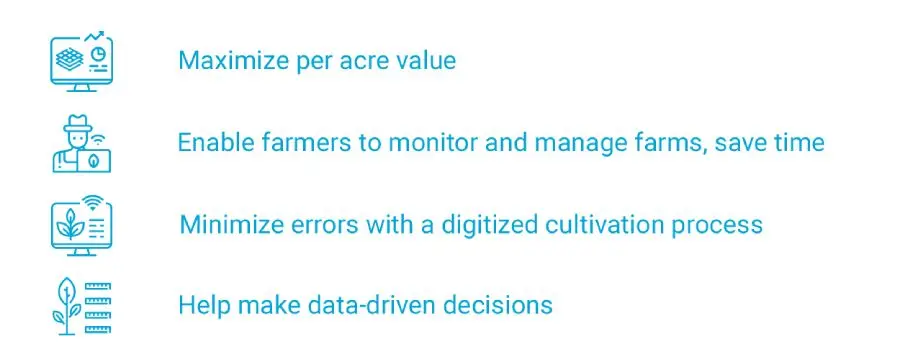Agricultural transformation– the key to resilient agri-food systems
According to a recent report by ReliefWeb, the current agriculture landscape is reeling from global food insecurity and malnutrition. The shocks and stresses to the current agricultural system have been amplified due to COVID-19. Plants provide over 80% of the food consumed by humans, making them the primary driver of food security and safety – and essential to preserving human life.
Seed producers and farming companies adopt agricultural transformation through digitalization, tools, and strategies to absorb these shocks and stresses and promote resilience. As a result, farmers benefit from increased productivity and improved livelihoods. There is better control over emissions and biodiversity loss. Digital farming is leading to resilient, inclusive, and efficient agri-food systems that are complex yet have a far-reaching impact on the community at large.
The multi-faceted challenges of farming
Estimates suggest that 3 billion people today do not have access to a healthy diet. To top it, the current agricultural landscape is troubled by:
- Biophysical and socioeconomic vulnerabilities
- Decrease in area of arable land
- Existing agricultural belts being pushed to the limits by cultivating multiple crops in a year
- Increasing population and mindless urbanization reducing existing pockets
Furthermore, essential agricultural inputs like energy and water are limited in supply and will be prioritized for human consumption. As agriculture irrigation accounts for 70% of water use and the food sector for 30% of the world’s total energy consumption, wastage of any scale can have disastrous effects. Existing water bodies are becoming too polluted and, by extension, becoming unsuitable for irrigation.
All these inevitably increase pressure on higher yield per acre. According to the 2022 State of Food Insecurity in the World (SOFI) report, the number of people affected by hunger rose to 828 million in 2021. As a result, the need to leverage Agritech solutions and drive end-to-end farming digitization is more critical now than ever.
Applying deeptech to drive modern agriculture transformation and nutritional security
Innovative techniques such as indoor and vertical farming are viable solutions, but they are a long way from becoming mainstream, practical, and scalable. This makes it vital to make the existing food and feed sources more resilient and boost nutritional security.
To drive modern agricultural transformation, the following strategies must be implemented in varying intensities and forms:
Setting up a resilient agri-food system with five distinctive capacities
The agri-food system should be able to prevent, anticipate, absorb, adapt, and transform to the changing socioeconomic and environmental conditions. This will strengthen the resilient capacity of agri-food ecosystems, empowering it to encounter predictable and unpredictable shocks. Of these, the absorptive capacity is vital to resisting unforeseen shocks and ensuring risk management of shocks that can be anticipated. To achieve absorptive capacity, the agri-food systems must include diversity in food sources (covering imports of existing stocks, domestic production, etc.), robust transport networks, and affordability of a healthy diet for all.
Laying the foundation for robust plant science
Plant science pertains to maintaining plant health and promoting the production of healthy, robust crops. It makes crops more resilient to pests and diseases, which costs the global economy an estimated $220 billion. It also helps improve the ability of plants to deliver more sustainable food systems.Driving risk management strategies to handle shocks
Crops face various risks such as drought, floods, and pests. Putting in place a crop-risk management strategy with multi-risk assessments, timely forecasts, predictive warning systems, and immediate action plans will ensure that agri-food systems can successfully anticipate and overcome significant disruptions.Technology is the key to unlocking a robust and resilient agri-food system
The use of deeptech tools and emerging technology becomes critical to achieving each of these end goals. From AI and ML to big data and smart farming technologies, wide-ranging agri-intelligent tools are available. For example, to improve farm productivity and profitability, Agritech pioneer Cropin offers farm digitization and business intelligence solution called Cropin Grow to:
Maximize per acre value
Enable farmers to monitor and manage farms, save time
Minimize errors with a digitized cultivation process

Help make data-driven decision

To monitor and mitigate risks, Cropin’s intelligent crop-risk management solution PlotRisk leverages predictive intelligence at the region, plot, and crop level. This platform uses AI/ML and big data to detect cropping patterns and forecast the crop’s future, highlighting associated risks and opportunities. It also provides predictive and prescriptive advisories to farmers about weather-based alerts, pest alerts, disease alerts, etc. It also offers real-time insights using satellite imaging and in-field sensors to monitor crops and gauge the ground truth.
Using technology in isolation will result in a half-baked attempt to promote nutritional security. There needs to be intensified government intervention and support to enable micro and macro benefits of resilient agri-food systems. Government institutions must mandate mainstreaming resilience in agri-food policies and drive greater collaboration of all stakeholders (small and medium agri-food enterprises, cooperatives, farmers, etc.) to ensure that policies are successfully fulfilled. Such a unified and transdisciplinary strategy is the only way to encourage nutritional security without pressuring the already overburdened agricultural ecosystem.








